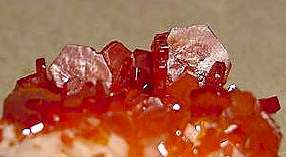Vanadinite
by
Dave Babulski, Ed.D.
("Tips and Trips", Vol. XXXIII/9, September 2004, page 10.)
This month we will look at the mineral vanadinite. In the world of mineral micromounts, vanadinite, with its typical red color and distinctive crystal forms, is a favorite among mineral micromounters. I would hazard a guess that just about every mineral micromounter has at least one vanadinite specimen in their collection. Vanadinite is classed as a lead chlorovanadate and is the result of the action of vanadium rich hydrothermal solutions in the oxidation zone of primary lead sulphide deposits. Vandanite is part of a chemical series with the minerals pyromorphite and mimetite and these three minerals are sometimes found in the same mineral deposit. Pyromorphite is a lead chlorophosphate and mimetite is a lead chloroarsenate. All three of these minerals have very similar crystal forms, varying primarly only in color. Although the pure form of each is colorless or very pale yellow, vanadinite is primarily red, pyromorphite is primarily green and mimetite is primarily yellow. Vanadinite crystallizes in the Hexagonal-Tripyrimidal form. The most common crystal habits are:
Vanadinite was first discovered at Zimapan, Hildago, Mexico and is named for its Vanadium content. I have noted that most of the Vanadinite seen at mineral shows in the past year is from the Moroccan mines. Vanadinite specimens from other locations are available from dealers on the internet and via mail order but you really have to "dig" for them. An interesting aspect of vanadinite in micromount form is the reflection of light from inclusions and internal fractures in the crystal. Although this mineral is primarily red in color, light reflected internally comes out as yellow. I have found that some of the vanadinite from the Hamburg Mine, when brightly illuminated looks like it is on fire! Some of the vanadinite from Mibladen, Morocco when brightly illuminated shows a beautiful shiller from many parallel reflective planes in the crystal.
- Squat tabular hexagonal plates. Crystals from the Mibladen, Morocco deposits occur in this crystal habit.
- Hexagonal barrel - shaped prismatic crystals. Crystals from the Wanlockhead in Dumfrieshire deposit in England exhibit this crystal habit.
- Hexagonal prisms with a flat termination face. Crystals from the Gila Mining District in Arizona show this crystal habit.
- Hexagonal prisms with complex pyramidal termination faces. Vanadanite crystals from the Hamburg mine, Trigo Mountains, La Paz County, Arizona are famous for transparent "gemmy", deep red prisms with complex pyramidal terminations. The complex terminations are only present in micromount size crystals. As the crystals grow larger, the complex terminations give way to a simple flat face crystal termination.
- Hexagonal "hopper" crystals. This is an indicator of very rapid crystal growth and occurs in most of the vanadinite deposits.
(Photograph by Doug Daniels)

Vanadinite crystals, Mibladen, Morocco
from the collection of Doug Daniels
Specimen is approximately 4 cm x 3 cm

Vanadinite crystals, Mibladen, Morocco
from the collection of Doug Daniels
Specimen is approximately 4 cm x 3 cm
Vanadinite was first discovered at Zimapan, Hildago, Mexico and is named for its Vanadium content. I have noted that most of the Vanadinite seen at mineral shows in the past year is from the Moroccan mines. Vanadinite specimens from other locations are available from dealers on the internet and via mail order but you really have to "dig" for them. An interesting aspect of vanadinite in micromount form is the reflection of light from inclusions and internal fractures in the crystal. Although this mineral is primarily red in color, light reflected internally comes out as yellow. I have found that some of the vanadinite from the Hamburg Mine, when brightly illuminated looks like it is on fire! Some of the vanadinite from Mibladen, Morocco when brightly illuminated shows a beautiful shiller from many parallel reflective planes in the crystal.

Copyright © Georgia Mineral Society, Inc.
